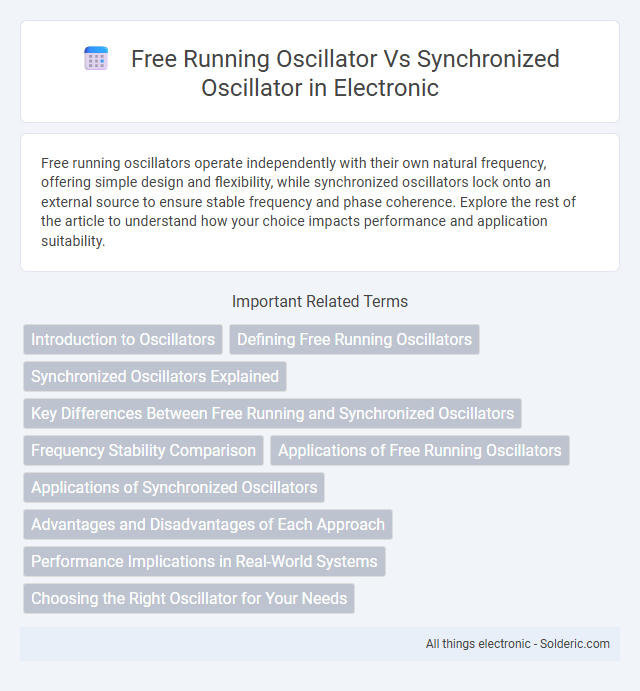Free running oscillators operate independently with their own natural frequency, offering simple design and flexibility, while synchronized oscillators lock onto an external source to ensure stable frequency and phase coherence. Explore the rest of the article to understand how your choice impacts performance and application suitability.
Comparison Table
| Feature | Free Running Oscillator | Synchronized Oscillator |
|---|---|---|
| Definition | Oscillator operating at its natural frequency without external control. | Oscillator locked to an external reference signal's frequency and phase. |
| Frequency Stability | Low to moderate; frequency can drift due to temperature and component variations. | High; frequency is stabilized by the external reference signal. |
| Phase Noise | Higher phase noise due to free-running nature. | Lower phase noise due to synchronization and phase locking. |
| Applications | Simple clocks, signal sources where precision is not critical. | Communication systems, phase-locked loops, frequency synthesizers requiring accuracy. |
| Control Complexity | Simple design, no external reference needed. | More complex, requires external reference and additional circuitry. |
| Power Consumption | Generally lower power consumption. | Possibly higher due to additional synchronization circuitry. |
Introduction to Oscillators
Oscillators generate periodic signals essential in electronics, with two main types being free running and synchronized oscillators. Free running oscillators operate independently at their natural frequency, while synchronized oscillators lock their frequency and phase to an external reference, enhancing stability and reducing jitter. Your choice between these oscillator types impacts signal precision and application performance in communication and timing systems.
Defining Free Running Oscillators
Free running oscillators generate continuous oscillations at a natural frequency determined by their internal components without external input or synchronization signals. Their frequency stability depends on component tolerances and environmental factors, leading to variations over time. Compared to synchronized oscillators, free running oscillators are simpler but less precise in frequency control, often used in applications where exact timing is not critical.
Synchronized Oscillators Explained
Synchronized oscillators maintain phase alignment by locking their output frequency to an external reference signal, ensuring consistent timing crucial for communication and signal processing systems. Unlike free running oscillators, which operate independently and may experience phase drift and frequency variations, synchronized oscillators enhance signal stability and reduce jitter in your applications. This synchronization leads to improved performance in systems requiring precise timing, such as clock generation and wireless networks.
Key Differences Between Free Running and Synchronized Oscillators
Free running oscillators generate signals at a natural frequency determined by their internal components, while synchronized oscillators align their output with an external reference signal, maintaining phase coherence. The key difference lies in stability and timing accuracy; free running oscillators may experience frequency drift, whereas synchronized oscillators ensure consistent frequency and phase locking, crucial for communication and signal processing applications. Your choice depends on whether precise synchronization or independent frequency generation is more critical for your system's performance.
Frequency Stability Comparison
Free running oscillators often experience significant frequency drift due to temperature changes, power supply variations, and aging components, resulting in lower frequency stability. Synchronized oscillators, locked to a reference signal such as a crystal or external clock, maintain much higher frequency accuracy and stability by reducing phase noise and jitter. Your choice between these oscillators impacts the precision of timing-sensitive applications, with synchronized oscillators preferred for enhanced frequency stability.
Applications of Free Running Oscillators
Free running oscillators are widely utilized in applications requiring autonomous signal generation without external synchronization, such as in clock generation for microcontrollers, simple carrier wave generation in RF transmitters, and sensor signal conditioning. Their ability to operate independently from input signals makes them ideal for timing circuits, waveform generation, and frequency synthesis in low-complexity electronic devices. Your choice of a free running oscillator can enhance system reliability in environments where external synchronization signals are unavailable or unnecessary.
Applications of Synchronized Oscillators
Synchronized oscillators are crucial in applications requiring precise timing and phase alignment, such as telecommunications, radar systems, and phased array antennas. Your communication devices benefit from synchronized oscillators by maintaining consistent signal integrity and reducing phase noise, essential for data synchronization and signal processing. These oscillators enhance the performance of distributed systems by ensuring coherent operation across multiple components.
Advantages and Disadvantages of Each Approach
Free running oscillators offer simple design and low power consumption, making them ideal for applications requiring independent frequency generation; however, they may suffer from frequency drift and lack of phase coherence. Synchronized oscillators provide improved frequency stability and phase alignment by locking to an external reference, enhancing signal integrity in communication systems, but they tend to be more complex and consume more power. Choosing between free running and synchronized oscillators depends on balancing requirements for stability, complexity, and power efficiency in the specific application.
Performance Implications in Real-World Systems
Free running oscillators often exhibit frequency drift and phase noise due to their autonomous operation, which can lead to timing inaccuracies in communication and control systems. Synchronized oscillators, synchronized to a master clock or reference signal, significantly improve timing precision and reduce jitter, enhancing system stability and performance in applications like network synchronization and high-speed data transfer. The choice between free running and synchronized oscillators directly impacts real-world system reliability, signal integrity, and overall operational efficiency.
Choosing the Right Oscillator for Your Needs
Free running oscillators generate signals independently without external synchronization, offering simplicity and cost-effectiveness for applications requiring stable frequency outputs. Synchronized oscillators, however, lock their phase and frequency to an external reference, ensuring precise timing and reduced jitter critical in communication systems and digital clocks. Your choice depends on whether your project prioritizes flexibility and ease of use or demands rigorous timing accuracy and signal coherence.
Free running oscillator vs Synchronized oscillator Infographic

 solderic.com
solderic.com